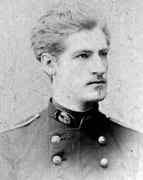Person: Cosserat, François

François Cosserat was a French engineer and mathematician known by his theories about deformable bodies written with his brother Eugène.
Mathematical Profile (Excerpt):
- The examination for entry to the École Polytechnique was highly competitive and François was ranked twenty-sixth among the successful candidates in that year.
- Along with seventeen other graduates from the École Polytechnique, Cosserat opted to continue his training at the École Nationale des Ponts et Chaussées.
- Cosserat became a Railway Engineer Second Class (Northern Zone) in 1879.
- The details we have given show that Cosserat had a highly successful career as a civil engineer.
- It is tempting to believe, therefore, that Eugène Cosserat would be the major player in their joint research but this would be far from the truth.
- During the period of their close collaboration, Eugène Cosserat was burdened by heavy administrative tasks and was only a very minor contributor.
- the main creative mechanical ideas (the most striking behind the computations) have been furnished by François, while Eugène, overburdened by management tasks at the Observatory of Toulouse, was just rectifying the computations.
- However, nothing on mechanics was published after 1914! Meanwhile, it is painful to know that, when François asked for a position in mechanics at the École Polytechnique, in competition with Hadamard (supported by Painlevé) and Jouguet, somebody pointed out doubts on his participation in this work in collaboration, and finally ...
- For example, the report written on 27 June 1898 states, "M François Cosserat is a distinguished engineer who has high practical experience.
- In addition to his normal position, he devotes himself to theoretical studies and he recently presented to the Académie des Sciences remarkable works on mechanics." The report of 11 October 1910 states, "M François Cosserat is a valued collaborator, highly efficient, especially in public works.
- He is known among the scientific community as the author of remarkable studies on questions of mathematics and mechanics." The report of 20 October 1913 states, "M François Cosserat has high competence for building tunnels, bridges, ...
- Cosserat began his mathematical studies considering a theory of elasticity but went on to consider broad questions concerning mechanics particularly relating to gravitational, electrical and thermal phenomena.
- The Cosserats themselves recognised the value of oriented two-dimensional continua (i.e., curves and surfaces endowed with additional structure in the form of directors) for representing the deformations of rods and shells respectively.
- Exceptions are also colleagues of Eugène Cosserat in Toulouse, like L Ray and A Buhl.
- Relativity Theory and Quantum Physics overtook this period in science and the work of E and F Cosserat was almost rediscovered after 1950 because of the use of liquid crystals.
- In addition to his mathematical research, François Cosserat made other contributions to mathematics through his expertise in languages.
- François Cosserat also began translating Elementary Principles in Statistical Mechanics (1902) by J Willard Gibbs from English to French but died before completing the task.
- After François Cosserat died, Ernest Vessiot succeeded him as President of the Société Mathématique de France.
- It is now clear that the qualities that Vessiot saw so clearly in their joint work were almost all due to François Cosserat.
Born 26 October 1852, Douai, France. Died 22 March 1914, France.
View full biography at MacTutor
Thank you to the contributors under CC BY-SA 4.0! 

- Github:
-

- non-Github:
- @J-J-O'Connor
- @E-F-Robertson
References
Adapted from other CC BY-SA 4.0 Sources:
- O’Connor, John J; Robertson, Edmund F: MacTutor History of Mathematics Archive
